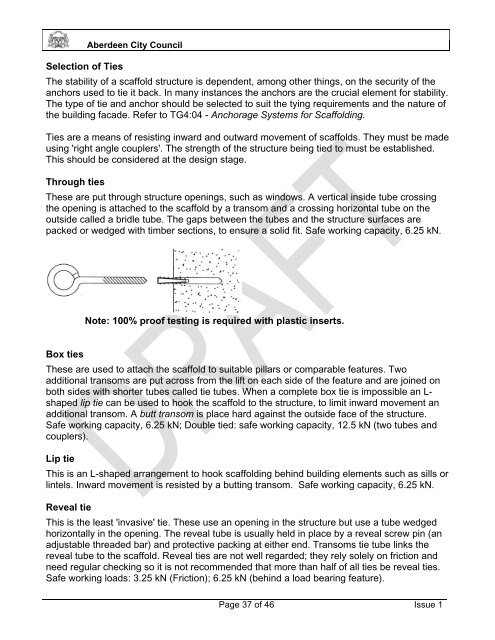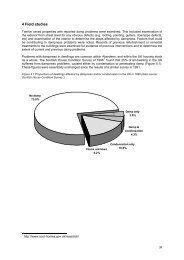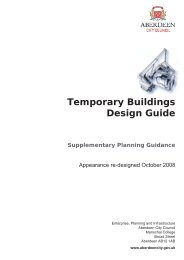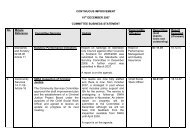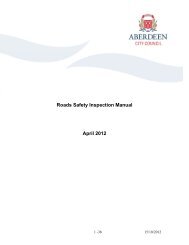Scaffold Protocol - Aberdeen City Council
Scaffold Protocol - Aberdeen City Council
Scaffold Protocol - Aberdeen City Council
- No tags were found...
Create successful ePaper yourself
Turn your PDF publications into a flip-book with our unique Google optimized e-Paper software.
<strong>Aberdeen</strong> <strong>City</strong> <strong>Council</strong>Selection of TiesThe stability of a scaffold structure is dependent, among other things, on the security of theanchors used to tie it back. In many instances the anchors are the crucial element for stability.The type of tie and anchor should be selected to suit the tying requirements and the nature ofthe building facade. Refer to TG4:04 - Anchorage Systems for <strong>Scaffold</strong>ing.Ties are a means of resisting inward and outward movement of scaffolds. They must be madeusing 'right angle couplers'. The strength of the structure being tied to must be established.This should be considered at the design stage.Through tiesThese are put through structure openings, such as windows. A vertical inside tube crossingthe opening is attached to the scaffold by a transom and a crossing horizontal tube on theoutside called a bridle tube. The gaps between the tubes and the structure surfaces arepacked or wedged with timber sections, to ensure a solid fit. Safe working capacity, 6.25 kN.Note: 100% proof testing is required with plastic inserts.Box tiesThese are used to attach the scaffold to suitable pillars or comparable features. Twoadditional transoms are put across from the lift on each side of the feature and are joined onboth sides with shorter tubes called tie tubes. When a complete box tie is impossible an L-shaped lip tie can be used to hook the scaffold to the structure, to limit inward movement anadditional transom. A butt transom is place hard against the outside face of the structure.Safe working capacity, 6.25 kN; Double tied: safe working capacity, 12.5 kN (two tubes andcouplers).Lip tieThis is an L-shaped arrangement to hook scaffolding behind building elements such as sills orlintels. Inward movement is resisted by a butting transom. Safe working capacity, 6.25 kN.Reveal tieThis is the least 'invasive' tie. These use an opening in the structure but use a tube wedgedhorizontally in the opening. The reveal tube is usually held in place by a reveal screw pin (anadjustable threaded bar) and protective packing at either end. Transoms tie tube links thereveal tube to the scaffold. Reveal ties are not well regarded; they rely solely on friction andneed regular checking so it is not recommended that more than half of all ties be reveal ties.Safe working loads: 3.25 kN (Friction); 6.25 kN (behind a load bearing feature).Page 37 of 46 Issue 1


